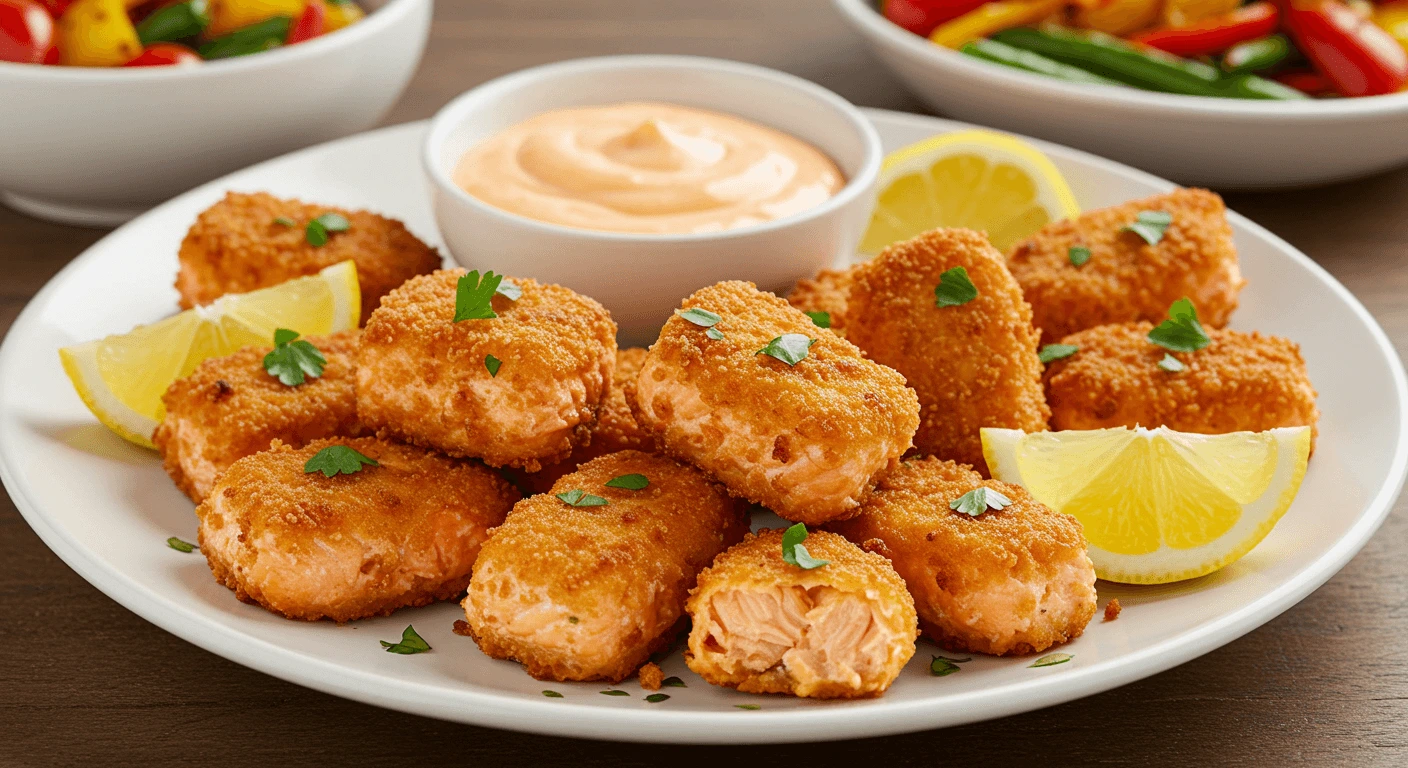If you’re looking for a quick, healthy, and tasty snack or appetizer, air fryer salmon bites are the perfect choice. These crispy, flavorful bites are both nutritious and satisfying, making them perfect for casual meals or special gatherings.
The air fryer’s magic lies in its ability to cook food evenly with minimal oil, delivering perfectly golden and tender salmon bites every time. Whether you’re a seafood lover or looking to incorporate more omega-3-rich dishes into your diet, this recipe is sure to impress.
With just a few simple ingredients and an air fryer, you can effortlessly create restaurant-quality salmon bites right in your own kitchen.
Why Choose Air Fryer Salmon Bites?
A Healthier Alternative to Fried Foods
Air fryer salmon bites strike the ideal balance between flavor and nutrition. By using just a small amount of oil—or none—you can enjoy the crispiness of fried food without the guilt. This cooking method keeps your meal light and heart-healthy, making it a great option for anyone watching their diet.
Quick and Convenient for Busy Days
Life can get hectic, and that’s where air fryer salmon bites shine. In just 10-15 minutes, you can have a delicious dish ready to serve. This recipe’s quick preparation and cooking time make it perfect for weeknight dinners, spontaneous gatherings, or a protein-rich snack.
Packed with Nutrition
Salmon is known for being a powerhouse of nutrients. Packed with omega-3 fatty acids, high-quality protein, and essential vitamins like B12 and D, these bites are as nourishing as they are delicious. Air frying preserves the natural nutrients in salmon, ensuring a wholesome meal every time.
Ingredients You’ll Need

Key Ingredients
For the perfect air fryer Salmon bites, you’ll require the following ingredients:
- Fresh Salmon: Choose skinless salmon fillets for easier preparation.
- Olive Oil: A light drizzle of oil helps achieve a crispy texture.
- Seasonings like garlic powder, salt, paprika, and black pepper enhance the salmon’s flavor and natural aroma.
Optional Additions
Make your salmon bites go up a notch by adding these ingredients that can be added to your salmon:
- Lemon Zest adds a fresh and citrusy note.
- Chili Flakes for a hint of heat.
- Fresh Herbs comparable to dill and parsley for adding flavor and freshness.
Tools for Success

With the right tools, you can have the most hassle-free cooking experience
- The Air Fryer is the main appliance in this recipe.
- Tongs for flipping and handling salmon bites.
- Silicone Brush ensures even coating of marinade or oil on the salmon.
- Mixing Bowls for seasoning and tossing salmon pieces.
Step-by-Step Guide to Making Air Fryer Salmon Bites
Preparing the Salmon
- Start with fresh, skinless salmon fillets.
- Cut the salmon into bite-sized chunks, approximately 1-1.5 inches.
- In a mixing bowl, toss the salmon pieces with olive oil to lightly coat them.
- Season generously with garlic powder, paprika, salt, and pepper. Enhance the flavor by adding optional ingredients such as lemon zest or chili flakes
Air Frying the Salmon Bites
- Preheat your air fryer to 400°F (200°C) for 3-5 minutes.
- Place the salmon bites in a single layer in the air fryer basket, leaving space between each piece to allow proper airflow.
- Cook the salmon bites for 8-10 minutes, flipping halfway through for even crispiness.
- Check for doneness: the salmon should be golden on the outside and tender and flaky inside.
Serving Suggestions
- Serve warm air fryer salmon bites with dipping sauces like tartar sauce, spicy mayo, or garlic aioli.
- Pair them with fresh salads, roasted vegetables, or a simple quinoa bowl for a complete meal.
- Enhance the presentation by garnishing with lemon wedges and fresh herbs.
Expert Tips for Perfectly Cooked Air Fryer Salmon Bites
Choose Fresh Salmon
The quality of your salmon makes a big difference in the final result. Choose fresh, skinless salmon fillets that are firm and display a vibrant pink hue. Avoid salmon with an overly fishy smell or dull appearance.
Don’t Overcrowd the Air Fryer
To achieve that perfectly crispy texture, make sure the salmon bites are arranged in a single layer with enough space for air to circulate. Overcrowding the basket can lead to uneven cooking. If needed, cook the bites in batches.
Experiment with Seasonings
While the classic garlic and paprika combo is a crowd-pleaser, don’t hesitate to try other flavor profiles. Teriyaki glaze, Cajun spices, or a sprinkle of sesame seeds can add unique twists to your salmon bites.
Monitor Cooking Time Closely
Salmon cooks fast, so monitor your air fryer closely to prevent overcooking. A meat thermometer can help you achieve the perfect temperature—145°F (63°C) for fully cooked salmon.
Conclusion
Air fryer salmon bites are a quick, healthy, and incredibly flavorful way to enjoy seafood at home. By choosing fresh salmon, experimenting with seasonings, and following the simple tips outlined in this post, you’ll achieve crispy, tender bites every time. These salmon bites will impress if you’re seeking a nutritious weeknight meal, a protein-packed snack, or a party-worthy appetizer.
Try this recipe, and feel free to tweak the flavors to suit your taste. Don’t forget to share your culinary creations with friends and family—who knows, you might inspire them to make their own perfect air fryer salmon bites!

How to Make Perfect Air Fryer Salmon Bites Every Time
Equipment
- Air Fryer
- Tongs
- Silicone brush
- Mixing bowls
Ingredients
Main Ingredients
- 1 lb 450g fresh skinless salmon fillets, cut into 1-1.5 inch pieces
- 1-2 tbsp olive oil
- 1 tsp garlic powder
- 1 tsp paprika
- Salt and black pepper to taste
Optional Additions
- Zest of 1 lemon
- ½ tsp chili flakes
- Fresh herbs like dill or parsley
Instructions
- Prepare the Salmon:
- Cut the salmon into bite-sized pieces (1-1.5 inches). Toss with olive oil to coat, and season with garlic powder, paprika, salt, and pepper. Optionally, add lemon zest or chili flakes for extra flavor.
- Preheat Air Fryer:
- Preheat the air fryer to 400°F (200°C) for 3-5 minutes.
- Cook the Salmon Bites:
- Arrange the salmon bites in a single layer in the air fryer basket, ensuring they don’t overcrowd. Air fry for 8-10 minutes, flipping halfway through for even crispiness. Ensure the salmon is golden on the outside and tender inside.
- Serve and Enjoy:
- Serve warm with dipping sauces like tartar sauce, spicy mayo, or garlic aioli. Pair with fresh salads, roasted vegetables, or quinoa for a complete meal. Garnish with lemon wedges and fresh herbs.
Notes
Expert Tips:
- Fresh Salmon is Key: Choose fresh salmon with a vibrant pink hue for the best flavor and texture.
- Avoid Overcrowding: For even crispiness, make sure the salmon pieces aren’t stacked or overcrowded in the basket.
- Experiment with Seasonings: While garlic and paprika are classic, try different seasonings like Cajun spices or teriyaki glaze to add variety.
- Check for Doneness: Use a meat thermometer to ensure the salmon reaches an internal temperature of 145°F (63°C) for optimal doneness.
FAQ
Can I Use Frozen Salmon?
Yes, you can! If using frozen salmon, thaw it completely before cutting it into bite-sized pieces. Pat the salmon dry with paper towels to remove excess moisture for better seasoning adhesion and crispier results in the air fryer.
How Do I Store Leftovers?
Keep leftover salmon bites in an airtight container in the refrigerator for up to three days. To reheat, use the air fryer at 350°F (175°C) for 2-3 minutes to restore their crispiness. avoid microwaving, as it may result in soggy salmon.
What Other Fish Can I Use?
If you don’t have salmon, substitute it with other firm fish like cod, halibut, or mahi-mahi. These choices maintain their shape and cook beautifully in an air fryer. Modify the cooking time based on the fish’s thickness.

